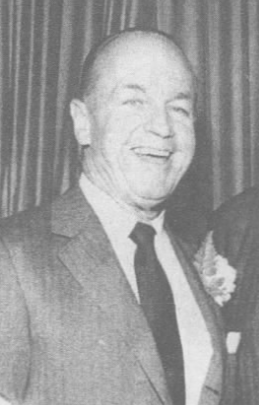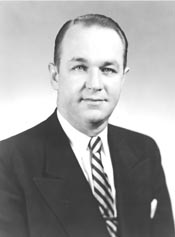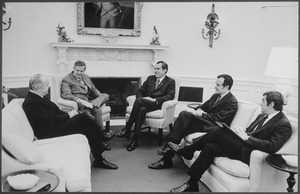William T. Cahill facts for kids
Quick facts for kids
William Thomas Cahill
|
|
|---|---|

Cahill in 1969
|
|
| 46th Governor of New Jersey | |
| In office January 20, 1970 – January 15, 1974 |
|
| Preceded by | Richard J. Hughes |
| Succeeded by | Brendan Byrne |
| Member of the U.S. House of Representatives from New Jersey |
|
| In office January 3, 1959 – January 19, 1970 |
|
| Preceded by | Charles A. Wolverton |
| Succeeded by | Edwin B. Forsythe |
| Constituency | 1st district (1959–1967) 6th district (1967–1970) |
| Member of the New Jersey General Assembly |
|
| In office 1951–1953 |
|
| Personal details | |
| Born | June 25, 1912 Philadelphia, Pennsylvania, U.S. |
| Died | July 1, 1996 (aged 84) Haddonfield, New Jersey, U.S. |
| Political party | Republican |
| Spouse |
Elizabeth Myrtetus
(m. 1941; died 1991) |
| Alma mater | Saint Joseph's University Rutgers University-Camden |
William Thomas Cahill (June 25, 1912 – July 1, 1996) was an American politician and lawyer. He served as the 46th governor of New Jersey from 1970 to 1974. Cahill was a member of the Republican party. Before becoming governor, he worked in the New Jersey General Assembly and the U.S. House of Representatives.
Contents
Early Life and Education
William Cahill was born in Philadelphia, Pennsylvania. His parents were Irish immigrants. In 1919, his family moved to South Jersey.
He went to Camden Catholic High School and finished in 1929. After high school, he studied at St. Joseph's College. This school is now known as Saint Joseph's University. He graduated from there in 1933. Cahill then returned to Camden to study law. He earned his law degree from the Rutgers School of Law - Camden in 1937.
Starting His Political Journey
In 1937 and 1938, Cahill worked as a special agent for the Federal Bureau of Investigation (FBI). In 1939, he became a lawyer. This marked the beginning of his career in politics.
Cahill lived in Collingswood, New Jersey. He served as the city prosecutor for Camden, New Jersey, from 1944 to 1945. Later, he was the first assistant prosecutor for Camden County from 1948 to 1951. In 1951, he also worked as a special deputy attorney general for New Jersey.
Serving in Congress
Cahill was a member of the New Jersey General Assembly from 1951 to 1953. He was then elected to the United States House of Representatives. He served in the House for six terms.
During his time in Congress, Cahill supported important laws. He voted for the Civil Rights Act of 1964. This law aimed to end discrimination. He also voted for the Voting Rights Act of 1965. This law helped protect the right to vote for all citizens. Cahill was seen as a moderate Republican during his time in Congress. He left the House in 1970 to become governor.
Governor of New Jersey
In 1969, Cahill ran for Governor of New Jersey. He won against Robert B. Meyner, who had been governor before. Cahill became the first Republican governor of New Jersey in 16 years. He took office on January 20, 1970.
Key Achievements as Governor
Cahill had a Republican-controlled legislature that supported him. During his time as governor, he achieved several important things:
- He introduced new rules for car emissions. These rules helped to reduce air pollution.
- The state sales tax was increased from 3% to 5%.
- The state lottery was started. This helped to raise money for the state.
- He helped pass "no-fault" auto insurance. This changed how car accident claims were handled.
- He played a role in bringing the New York Giants football team to a new stadium in the Hackensack Meadowlands.
In 1971, there was a peaceful end to a prison uprising at Rahway State Prison. Governor Cahill's actions in resolving this situation were praised. He also set up a group to suggest a state income tax. This idea was not popular with voters at the time. The proposal was not approved in 1972. However, a state income tax was finally put in place four years later, after Cahill had left office.
Challenges and Re-election
Despite his successes, Cahill's time as governor faced some challenges. Issues arose involving people in his administration. These problems affected his public image.
In 1973, Cahill ran for re-election. Because of the issues linked to his administration, he lost the Republican primary election. He was defeated by Congressman Charles Sandman. Sandman then lost the main election to Democrat Brendan Byrne.
During his last months as governor, Cahill appointed his predecessor, Richard J. Hughes, to a high position. Hughes became the chief justice of the New Jersey Supreme Court.
Later Life and Legacy
After his term as governor ended in 1974, Cahill became a senior fellow at Princeton University. He worked there until 1978.
William Cahill passed away on July 1, 1996, at his daughter's home in Haddonfield, New Jersey. He was 84 years old. Many important people attended his funeral, including current and former governors. He was buried at Calvary Cemetery in Cherry Hill Township, New Jersey.
A learning center at Ramapo College in Mahwah, New Jersey, was named in his honor. It is called the William T. Cahill Center for Experiential Learning and Career Services.
See also



